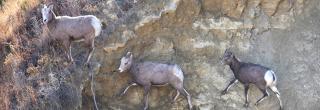 |
| Fact Sheet |
| Scientific Name |
Ovis canadensis |
| Description |
Averages 36 inches and 40 inches at the shoulder for ewes and rams, respectively. Mature rams average 230 pounds but can grow to over 300 pounds; ewes average 125 pounds (range 105-145pounds). Coat is grayish-brown, with cream-colored belly and white rump patch. Males have massive horns that spiral back and out to form a complete arc of more than 35 inches in length. Ewes have much smaller 8 to 10-inch sickle-shaped horns. |
Tracks |
Bighorn sheep tracks: Front track slightly larger Front–2-1/8" - 3-3/8" L, 1-1/2" - 3" W. Rear–2" - 3-1/4" L, 1/2" - 2-3/8" W. Walking stride: 12"-25". |
| Habitat |
Highly dependent upon open grasslands adjacent to rugged escape terrain where lambs are secure from predators. Encroachment of woody vegetation such as Rocky Mountain juniper has significantly degraded bighorn sheep habitat in North Dakota. |
| Food |
Bighorns browse on grasses, clover and sedges in warm months, and woody plants like willow, sage and rabbit brush in cold months. |
| Range |
Bighorn sheep are found only in steep badlands terrain along the Little Missouri River. |
| Mating |
Rams typically migrate to home ranges of ewes in mid-October, with the rut peaking during November through early December. No permanent pair bonds. Gestation averages about 180 days. |
| Young |
One lamb usually born in early May (range from mid April to mid June), weighing 8-10 pounds. Coat is grayish-brown. Lambs are not hidden in vegetation like fawns, but develop rapidly and typically stay by their mother’s side after just a few days. |
| Habits |
Most active during the day while they forage and bed near exposed escape terrain. Ewes and lambs usually in groups of 10 or more. Outside of the breeding season, rams are typically in bachelor groups. |
| Fun Facts |
Bighorn sheep are the rarest big game species in North Dakota. The total population in North Dakota is approximately 330 animals. Bighorn sheep were first recorded for science by the Lewis and Clark expedition in 1805 along the Yellowstone River in what is now North Dakota. The head of a mature ram accounts for 12 percent of its total body weight. Rams often break the tips of their horns while clashing during the rut. Regardless of age, rams with the largest horns and bodies usually outcompete smaller rams during the rut. Rams can exert a force three times their body weight while clashing during the rut. Lambs are usually faster than their mothers by a month old. A newborn lamb will hide beneath its mother’s belly to evade attacks by golden eagles. |


